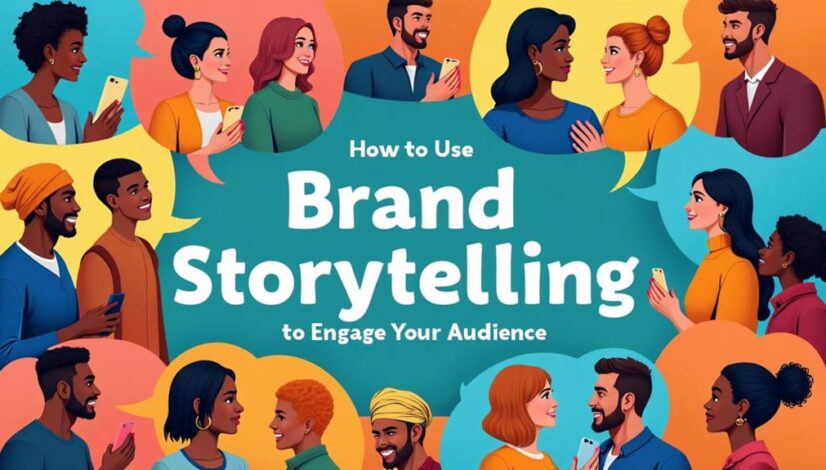How to Use Brand Storytelling to Engage Your Audience
To engage your audience through brand storytelling, start by understanding their values and emotions. Craft a core message that reflects your brand's essence and resonates with your target demographic. Develop a compelling narrative that features relatable characters and authentic experiences, fostering emotional connections. Incorporate visual storytelling to enhance engagement, utilizing imagery that captures attention and communicates your message effectively. Finally, measure engagement metrics to gauge your audience's response and adapt your strategy accordingly. By implementing these steps, you can create powerful stories that inspire loyalty and action, further enriching your brand's impact. Discover more insights in this area.
Key Takeaways
- Understand your audience's demographics and motivations to tailor your storytelling for deeper engagement.
- Define your brand's core message to create emotional connections and consistent communication across all platforms.
- Develop relatable characters in your narrative to humanize your brand and resonate with audience values.
- Utilize compelling visuals to enhance storytelling, making complex ideas accessible and memorable for your audience.
- Measure engagement through metrics and feedback to refine your narrative and align with audience preferences.
Understand Your Audience

How well do you truly know your audience? Understanding your audience is not merely a matter of collecting statistics; it's about delving deep into the nuances of their preferences, values, and emotional triggers. Audience demographics—age, gender, income, education—provide a foundational framework, yet they only scratch the surface.
To engage effectively, you must explore the underlying motivations that drive your audience's behaviors and decisions. Consider the emotional triggers that resonate with your target demographic. What fears, aspirations, or desires compel them to act? Crafting a brand narrative that aligns with these emotional touchpoints can foster a profound connection, transforming passive observers into engaged advocates.
For instance, a brand targeting environmentally conscious consumers might emphasize sustainability not merely as a product feature but as a shared value, evoking a sense of purpose and belonging.
Moreover, segmentation allows for tailored messaging that speaks directly to distinct audience groups. By understanding the varied demographics within your audience, you can create personalized stories that resonate on a deeper level, enhancing engagement and loyalty.
In an era where consumers are inundated with choices, the brands that stand out are those that demonstrate a genuine understanding of their audience. By investing time and resources into audience research—beyond mere demographics—you position your brand to create compelling stories that not only captivate but also inspire action.
In mastering this art, you lay the groundwork for meaningful engagement that transcends transactional relationships.
Define Your Brand's Core Message
A clear and compelling core message is vital for any brand seeking to resonate with its audience and foster long-lasting connections. This message encapsulates your brand values, serving as a guiding principle that informs every interaction and touchpoint.
By articulating your mission statement with precision, you create a foundation upon which your brand can build an emotional connection with consumers.
To define your core message, consider what differentiates your brand in a crowded marketplace—your unique selling proposition. This aspect not only highlights what sets you apart but also resonates with the aspirations and needs of your audience.
An authentic voice is significant here; it must reflect your brand's personality and ethos, ensuring consistency across all communications.
Employing effective storytelling techniques can further amplify your core message. Through narrative, you can weave your brand values into engaging stories that captivate and inspire.
These stories should evoke emotions, allowing your audience to connect with your brand on a deeper level. Whether through customer testimonials, founder stories, or case studies, each narrative should reinforce your core message and demonstrate how your brand fulfills its mission.
Craft a Compelling Narrative

Creating a compelling narrative is crucial for brands aiming to engage their audience meaningfully. A well-crafted story not only captures attention but also fosters a deep connection with consumers, transforming them from passive viewers into active participants in the brand's journey. This engagement is rooted in character development and emotional resonance, which are critical elements in storytelling.
Character development allows brands to humanize their narrative. By introducing relatable characters—whether they be customers, employees, or even the brand itself—companies can create an emotional bridge. These characters should embody the brand's values and mission, allowing the audience to see themselves reflected in the narrative. This connection is essential; when consumers identify with the characters, they are more likely to forge a lasting relationship with the brand.
Emotional resonance is equally important in crafting a compelling narrative. Stories that evoke strong emotions—be it joy, nostalgia, or empathy—tend to leave a lasting impact. To achieve this, brands should weave in authentic experiences and challenges that their audience can relate to. By sharing moments of vulnerability or triumph, brands can evoke empathy and inspire action.
Ultimately, a compelling narrative is not merely about the brand's achievements but about creating a shared experience. By focusing on character development and emotional resonance, brands can engage their audience on a deeper level, fostering loyalty and advocacy that transcends traditional marketing approaches.
Therefore, mastering narrative crafting is a pivotal strategy in effective brand storytelling.
Utilize Visual Storytelling
Building on the foundation of compelling narratives, visual storytelling emerges as a powerful technique that amplifies brand engagement. By leveraging the imagery impact of visuals, brands can transcend the limitations of text and create a more immersive experience for their audience. Images, videos, and infographics not only capture attention more effectively but also communicate complex ideas in a digestible format.
The emotional connection formed through visual elements is profound; studies indicate that people are more likely to remember information when it is paired with relevant images. When brands employ visuals that resonate with their target demographic, they evoke feelings that drive loyalty and inspire action. For instance, a poignant photograph can encapsulate a brand's ethos or mission, fostering a sense of belonging among consumers who share similar values.
Furthermore, the strategic use of color, composition, and design can enhance storytelling, guiding the viewer's emotional journey. Each visual element should be thoughtfully curated to reinforce the narrative and strengthen the brand identity.
Incorporating visual storytelling into your marketing strategy is not merely an aesthetic choice; it is a tactical advantage that can differentiate your brand in a crowded marketplace. By understanding the psychology of imagery impact and the importance of emotional connection, brands can craft compelling visual narratives that resonate deeply with their audience, ultimately leading to increased engagement and loyalty.
Embrace the art of visual storytelling, and watch your brand narrative come to life.
Measure Engagement and Adapt

Engagement metrics serve as the pulse of a brand's storytelling efforts, providing invaluable insights into how audiences interact with content.
To harness the full potential of your narrative, it is crucial to measure these metrics regularly and adapt your strategy accordingly. This process guarantees that your storytelling resonates with your audience and evolves in alignment with their preferences.
Consider the following key engagement metrics:
- Click-Through Rates (CTR): Analyze how many users are compelled to explore your content further. A higher CTR indicates that your narrative successfully captures attention.
- Social Shares: Monitor how often your content is shared across social media platforms. This metric reflects the emotional connection your audience feels toward your story, amplifying its reach.
- Audience Feedback: Collect qualitative data through comments, surveys, and direct messages. This feedback provides insights into what aspects of your storytelling are most impactful and where improvements are needed.
Frequently Asked Questions
How Long Should My Brand Story Be for Maximum Impact?
Determining the ideal story length for maximum impact hinges on your audience's preferences and the platform used.
Generally, concise narratives—ranging from 100 to 300 words—tend to foster greater audience engagement by capturing attention swiftly.
However, more complex tales, up to 1,500 words, may resonate deeply if the content is rich and compelling.
Ultimately, the key lies in balancing brevity with substance, ensuring your brand's message is effectively communicated without losing your audience's interest.
Can I Use Humor in Brand Storytelling Effectively?
Humor in brand storytelling can be a double-edged sword; it can either foster connection or alienate your audience.
By strategically employing various humor types, such as situational or self-deprecating, brands can evoke positive audience reactions while enhancing relatability.
However, the key lies in understanding your target demographic to avoid misinterpretation.
When executed thoughtfully, humor not only captivates but also leaves a lasting impression, ultimately reinforcing brand loyalty and engagement.
What Platforms Are Best for Sharing My Brand Story?
Identifying the best platforms for sharing your brand story is essential for maximizing engagement.
Social media channels, such as Instagram, Facebook, and LinkedIn, offer dynamic opportunities for visual storytelling, enabling brands to connect with audiences through compelling images and videos.
Additionally, platforms like YouTube can enhance narrative depth, while blogs provide a space for detailed storytelling.
Leveraging these platforms strategically fosters a stronger emotional connection, ensuring your brand story resonates with your target audience effectively.
How Often Should I Update My Brand Story?
Updating your brand story is essential to reflect brand evolution and maintain relevance. Ideally, review and revise your narrative annually or in response to significant changes within your organization or target market.
Additionally, incorporate audience feedback to guarantee your story resonates with your audience's evolving preferences and values. A dynamic brand story not only fosters engagement but also builds trust, positioning your brand as a relatable and authentic entity in a competitive landscape.
What Are Some Common Mistakes in Brand Storytelling to Avoid?
In brand storytelling, the juxtaposition of authenticity and emotional resonance is critical; however, many brands falter by succumbing to authenticity pitfalls.
They may fabricate narratives that lack genuine connection, leading to skepticism among audiences.
Additionally, neglecting to align the story with the brand's core values can create dissonance.
To master storytelling, brands must guarantee their narratives are sincere and relatable, fostering trust and deeper engagement with their audience.
Conclusion
In the domain of brand storytelling, the effectiveness of engagement lies in the alignment between narrative and audience perception. Research indicates that consumers are more likely to connect with brands that convey authentic stories resonating with their values and experiences. This alignment fosters brand loyalty and advocacy, underscoring the critical role of storytelling in marketing strategies. Consequently, through thoughtful narrative construction and audience understanding, brands can cultivate deeper relationships that transcend mere transactional interactions.




